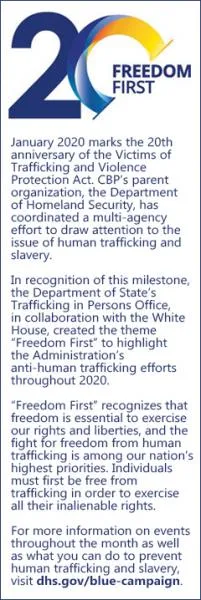
As January marks the 20th anniversary of the Victims of Trafficking and Violence Protection Act of 2000, CBP serves as frontline defense against human trafficking and forced labor.
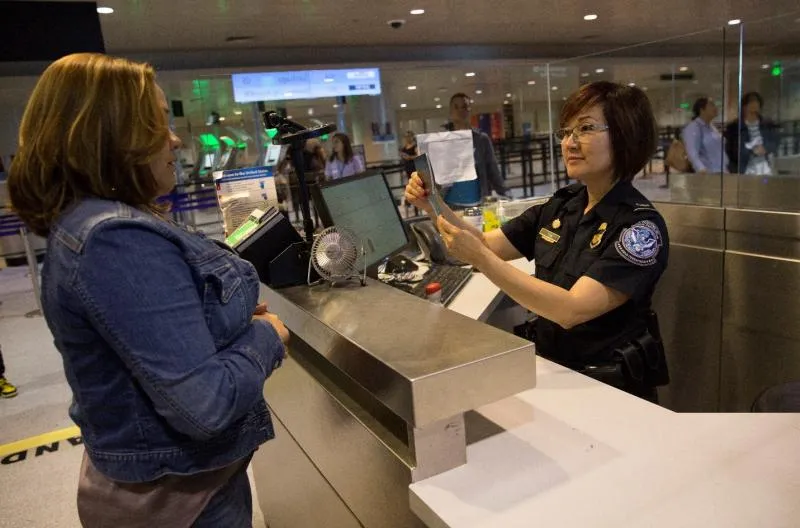
passenger at Boston Logan International
Airport. Photo by Glenn Fawcett
It’s a problem of epic proportions but many times hides in plain sight. Worldwide, the United Nations estimates more than 40.3 million adults and children are enslaved through human
trafficking and forced labor at any given time, with the slave laborers exploited by the private sector in other countries to do domestic work, construction or agriculture. About 4.8 million are victims of the commercial sex industry, many times young women and minors. It’s something U.S. Customs and Border Protection Officer Lisa Caselli saw firsthand.
During an encounter with a young Russian woman who was trying to enter the U.S., Caselli questioned her about why she was coming into America, how she obtained her visa, and what she would be doing in this country. While not evasive, Caselli found the woman’s answers vague and not making sense, tipping off the CBP officer to a possible crime.
“She wasn’t trying to get over on me; she genuinely believed she was coming as a model. But based on what she presented to me and what she was saying, I believed she was a victim of human trafficking,” Caselli said of the encounter more than a dozen years ago. “I said to her, ‘I believe that tonight you’ll be in a brothel, and you’ll be a prostitute.’”
The woman was shocked, but Caselli told her it didn’t appear to be a real job with a genuine modeling agency. The young woman was sent back to Russia, because at the time, CBP had no mechanism in place to deal with human trafficking. But that has changed. Caselli is a program manager in CBP who works with airline carriers to identify human trafficking victims and get them to the right law enforcement authorities, as well as non-profit groups who can help. “Now we refer them to non-government services and people [in the U.S. government, including Homeland Security Investigations] to help with trafficking victims.”
With more than 42,000 CBP officers and Border Patrol agents along the nearly 7,000 miles of land border and 328 ports of entry, the agency is uniquely positioned to deter and disrupt human trafficking. Those on the border and the ports of entry are many times the first law enforcement officers victims might encounter. Through an online course and mentoring from senior officers and agents in the field, CBP trains all its frontline law enforcement personnel to recognize the signs of human trafficking and the immediate actions necessary to protect the innocent. The first step is identifying victims.
Looking for the Signs
CBP officers and Border Patrol agents are trained to look for several signs of possible human trafficking. A victim:
- Lacks control of identification documents or travel documents
- Lacks freedom of movement
- Shows signs of having been abused or physically assaulted. Such signs range from the more obvious, such as broken bones, to the more subtle, such as branding or tattooing
- Seems submissive or fearful in the presence of others
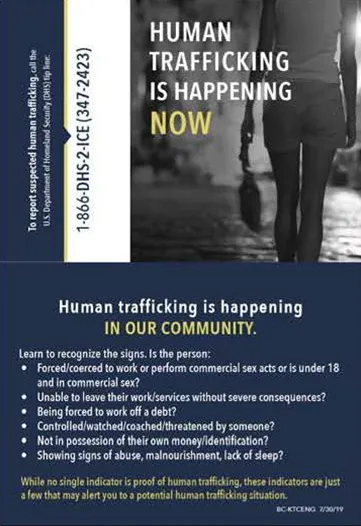
provides a variety of materials to help officials and the
public recognize the signs of human trafficking.
Source: Department of Homeland Security
Beyond these signs, Caselli said officers and agents are taught how to ask the right questions.
“When we do interviews, we are trained to ask the questions, listen to the answers, and follow up with more questions,” she said. “You have to make sure you’re listening to what they’re saying.”
For example, a CBP officer might ask if someone has ever been arrested, the entrant answers, “Yes,” and the officer moves on to the next question, “Why are you coming to the U.S.” Caselli said they’re taught to make sure they listen to that yes answer and follow up with when and why the person was arrested. “Don’t just get into the zone; you have to listen to the answers and follow up on what they said,” she said.
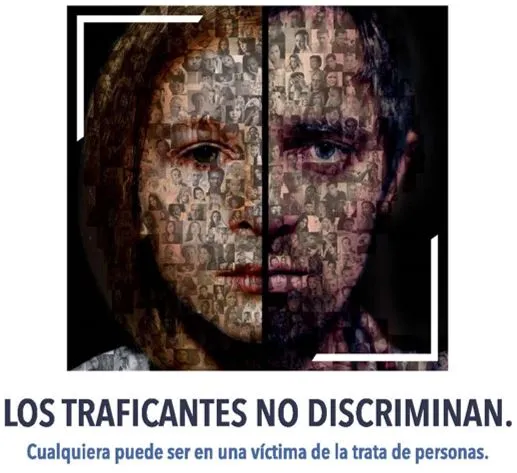
Blue Campaign also has materials
available in languages other than English.
Source: Department of Homeland Security
Furthermore, CBP officers and Border Patrol agents are taught to look for telltale signs: children coming off a long, tiring flight being too well-behaved while waiting in line, how people are interacting with each other – especially if someone is acting too shy or submissive, as well one person not letting the others speak and controlling the travel documents. But Caselli said they also recognize other cultures might not conform to the American standard, or the lead person in the group might be the only one who speaks English well enough. She said screening a passenger is a very fine art of looking for subtleties.
“You have to take into consideration where the person is coming from, what the family dynamic is,” adding in some male-dominated cultures, the husband might be the only one who speaks or even makes eye contact with the officer or agent. “That doesn’t indicate there’s trafficking going on; it’s cultural. You can’t make a blanket assumption for everybody.”
Blue Lightning Initiative
While CBP trains its men and women to recognize the signs and intervene, the agency also enlists the aid of more sets of eyes outside of CBP. Through the Blue Lightning Initiative, CBP, its parent organization – the Department of Homeland Security, and the U.S. Department of Transportation train airline workers what to look for and how to report suspected human trafficking. So far, more than two dozen airlines and more than 100,000 workers in the aviation industry have been trained. It’s just a short, 17-minute training video, but Caselli said, once they know what to watch for, these workers recognize the indicators of human trafficking and know how to be proactive and report it to the Homeland Security Investigations tip line.
“Airline personnel know their jobs, so if you just direct them what to look for, they will recognize the signs,” she said, adding another key point they teach airline workers is never to confront the victim or trafficker; instead they are taught to call the tip line’s director of field operations for the Houston area.
Officials also pointed out that human trafficking is the second largest criminal enterprise in the world – just behind drug smuggling, generating an estimated $31.6 billion in profits to criminal organizations that use the money to fund other crimes and possibly terrorist actions. “There are myths that human trafficking doesn’t happen in the United States, but that’s not true; it happens in every country,” Caselli said. Eventually, many victims of human trafficking are exploited as slaves and coerced into forced labor around the globe.
Slave/Forced Labor
The United Nation’s International Labour Organization estimates that about 25 million people are trapped in forced labor worldwide, producing dozens of items ranging from cotton to gold (see the recent Frontline article, “CBP Takes Aim at Forced Labor”). Sixteen million victims find themselves working in private sector industries such as mining, agriculture, and construction, while 4 million work directly for state authorities. Others, like the young woman Caselli suspected, may be sold in the commercial sex trade.
In order to prevent and disrupt the importation of products generated by forced labor, CBP created the Forced Labor Division within the Office of Trade to enforce the law outlined by the Trade Facilitation and Enforcement Act of 2015 – better known as TFTEA – which amended rules regarding imports produced by forced labor. CBP analysts in the Forced Labor Division accept allegations of forced labor from a variety of sources, review and investigate those allegations, and, if the evidence supports it, pursue enforcement actions to prevent the importation of such goods.
“CBP is firmly committed to identifying and preventing products made with the use of forced labor from entering the stream of U.S. commerce,” said Brenda Smith, Executive Assistant Commissioner, CBP Office of Trade. “Our agency works tirelessly behind the scenes to investigate and gather information on forced labor in global supply chains.”
When information reasonably but not conclusively indicates that the merchandise being imported was produced using forced labor, CBP’s commissioner may issue a withhold release order, allowing CBP to detain the goods. Once the order is in place, importers have the opportunity either to re-export the detained shipments at any time, or to submit information to CBP demonstrating that the goods are not in violation of the law. However, the goods in question may not enter the country at any point until the importer sufficiently demonstrates that they were not produced by forced labor.
Since the enactment of TFTEA, CBP has issued 13 withhold release orders covering various countries and products suspected of forced labor violations, seven of which were issued in 2019. Most recently, CBP issued orders covering clothing from a company in Xinjiang, China; disposable rubber gloves from a company in Malaysia; gold mined in artisanal small mines in eastern Democratic Republic of the Congo; rough diamonds from the Marange diamond fields in Zimbabwe; bone black manufactured in Brazil; and tobacco products from Malawi.
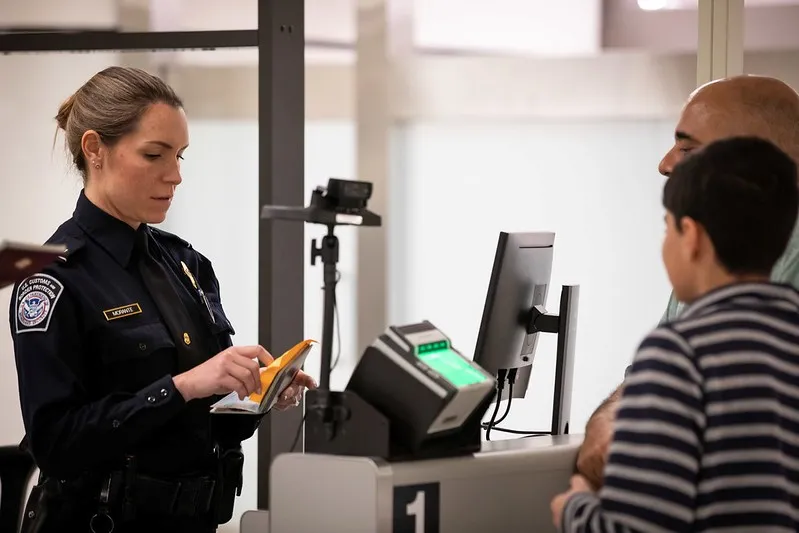
the Jacksonville, Florida, international
airport. Photo by Ozzy Trevino
“We want to send a message that we’re holding our business community to a standard of not using forced labor in their supply chains, and that companies must know their entire supply chain,” Smith said. Ultimately, CBP’s goal is to protect the victims of human smuggling and human trafficking by sending the message that the United States will not support the practice of forced labor in the manufacturing of U.S. goods.
A Crime Against the Person
Many people confuse human smuggling with human trafficking. But Caselli said while some people are smuggled in for the purposes of being trafficked later on, the real key is what or who is victimized.
“Smuggling is a crime against the border, but trafficking is a crime against the person,” she said. While smugglers often treat their people as just cargo designed to be dropped off and forgotten, traffickers want to make sure their victims arrive with no issues preventing them from entering the country.
While Caselli wishes she could have done more for the young Russian woman years ago, she’s glad all CBP officers and Border Patrol agents have more tools to help them prevent this crime.
“We are getting better at recognizing the signs of human trafficking and reporting has increased,” she said, adding human trafficking is a preventable crime, and CBP is key in stopping it. “The victims are often afraid to seek help because of threats from the trafficker. It’s only after the agent or officer builds a relationship with the person that the victim will admit they are being threatened.”


